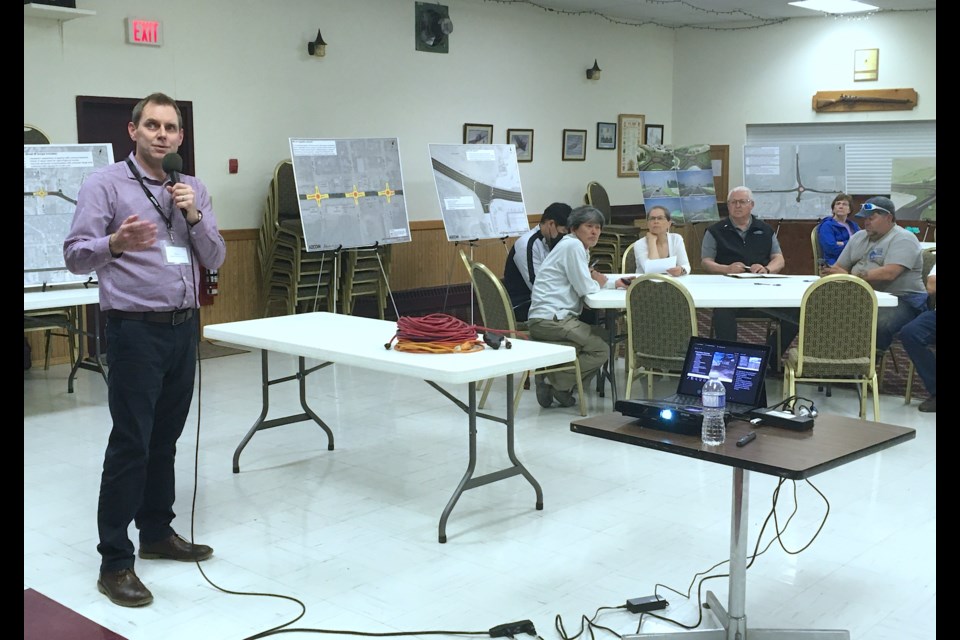SUNDRE — Although a specific timeline for construction remains elusive with hopes to get started next year, the permanent redesign of the Highway 27-Main Avenue high load corridor through town has officially been announced.
The project is, as of currently available estimates, expected to cost about $11.5 million.
The intersection of Highways 27 and 760 – the latter more commonly known locally as the Bergen Road immediately east of the Red Deer River Bridge – is to be upgraded with traffic lights to better enable northbound motorists on Highway 760 to turn west onto Highway 27, which during peak traffic times can be all but impossible.
And on the opposite side of town, the junction at Highway 22-27 with Highway 584 west will be upgraded to a single-lane roundabout to better enable southbound traffic coming down Highway 22 to turn east onto Highway 27.
Meanwhile, the mini temporary roundabouts located along Highway 27-Main Avenue through the downtown core at the 2nd, 3rd and 4th Street intersections that were installed in 2018 as part of a pilot project with the goal of not only improving pedestrian safety but also reducing speed while maintaining the flow of traffic, are set to be replaced with permanent concrete structures with softer, more tapered slopes than the current hard edges. The intersection at 1st Street NW will become a right-in, right-out only intersection, with a sole exception for emergency vehicles.
Alberta Transportation has engaged AECOM to provide the preliminary and detailed engineering designs and the construction administration of the project.
Representatives from both Alberta Transportation and AECOM were at the Royal Canadian Legion Sundre Branch #223 on Tuesday, June 28 from 3-8 p.m., with a presentation at 5:30 p.m. attended by more than two dozen people, but several dozen came throughout the whole day.
Among them were Stuart Richardson, an infrastructure manager for Alberta Transportation, who presented a slideshow breaking down the details.
The largely finalized design – which could be slightly altered, pending input, but will for the most part reflect the final product – was engineered to better accommodate heavy loads. Richardson recognized the past mistake of forcing traffic closer to the sidewalks at the intersections over pavement that could not handle the weight of oversized loads and ended up requiring regular pothole repairs.
The intersections with the temporary roundabouts will be totally rebuilt to address drainage as well, he said.
“The drainage had been a problem,” he said. “Potholes galore along here for the last few years.”
That’s because the intersections were standard and not designed for roundabouts, he said.
“These are being engineered for roundabouts now, whereas they weren’t before,” he said.
While every effort will be made to mitigate the impact on local traffic during the course of construction, some delays will naturally be unavoidable, he said.
“There’s no sugar coating it,” he said. “It’s one construction season; we’re asking for patience.”
Following the initial installation of the temporary roundabouts, he said many people were unhappy with the pilot project, but added plenty were also quite pleased with it and that some feedback was considered.
And to ensure regular traffic drives closer to the road’s centre dividing line and away from sidewalks at each downtown intersection, concrete bulb-outs that larger loads can drive over will also be added, he said.
After concluding his nearly 25-minute presentation, Richardson opened the floor to questions.
The first question asked was about the project’s anticipated construction timeline.
“It’s in our construction program for next year,” said Richardson. “As far as we’re aware, that’s not going to change.”
Once the project is tendered early in 2023, a contractor will be brought on board.
“Hopefully, we start May-June next year,” he said. “It’s going to go all through the summer, probably end in the fall, because there’s a lot of concrete work.”
Asked what happens in the event the new design fails, he replied, “We’re hoping they don’t fail us, that’s the whole point of this design.”
Additionally, he said Alberta Transportation has plenty of other projects on its plate.
“We don’t want to be back for another 20 years,” he said.
And of course the question about whether an alternate high load corridor has ever been considered also came up.
“We’ve looked at that,” said Richardson, adding a corridor study was conducted for the whole province and that none of the other bridges in the area can accommodate the oversized dimensions and weight of heavy industrial traffic.
One of the last questions was if the presented design is set in stone or whether any input was still being considered.
“We’re not opposed to making some changes. But just know this is our plan to go ahead,” said Richardson, adding he intended to take some of the evening’s feedback to AECOM.
“So, unless there’s something seriously wrong with what we’ve got, we’re going ahead with the majority of it.”



